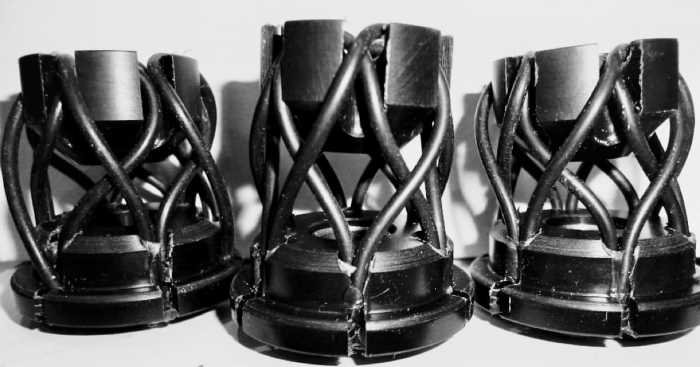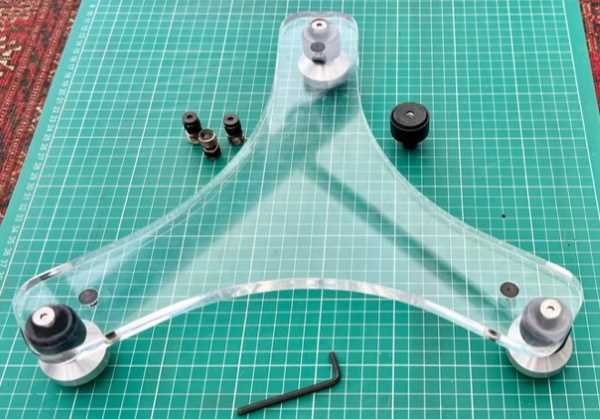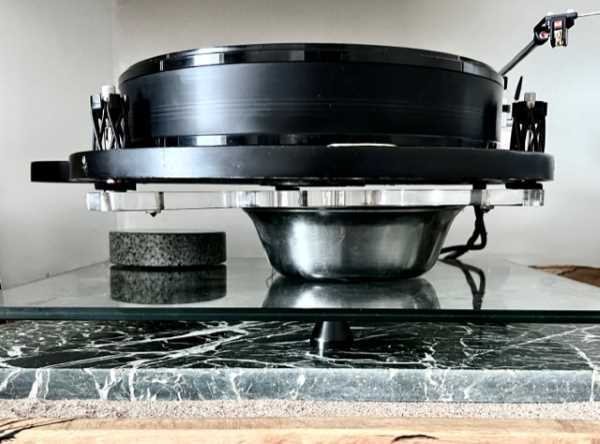
[ Home TNT-Audio | Staff & Contacts | HiFi Playground | Listening tests | DIY & Tweakings | Music & Books]

Product: Pete's Pylons for Michell turntables
Supplier: True Point Audio
Price: Basic £160, Original £200 (with spare O-rings, sorbothane pads & ceramic balls), Pete's Pads (feet) £125 per set
(see follow up review) via ebay shop, evidence that
YMMV depending on choices
Author: Mark Wheeler - TNT UK
Reviewed: Spring to Autumn 2023
The Michell Orbe and Orbe SE are massively constructed turntables. They are the flagships of the Michell turntable range. The Orbe has 2 levels of high density acrylic layers to isolate the platter from motor and external vibration. The Michell Orbe features a monumental 60mm thick impedence matched platter. The original models from 1994 were all black brooding presences compared with the hypnotic Michell Gyrodec. Amazingly the Michell turntables have reduced in price in real terms since their first introduction. Overall, although other turntables do certain things better, nothing comes close at Michell turntable price points, which is a testament to their inherent design and to economies of scale. The Michell Orbe and Michell Gyrodec have now been around long enough to attract a thriving aftermarket seeking to improve on the original design and manufacture.
Following the complexity and expense of the Gert Pedersen solution to suspended subchassis bloom and instability on the Michell Orbe and Gyrodec models, the simpler to install Pete's Pylons are in for review. Pete's Pylons do not require drilling of subchassis nor new SE spiders nor chambers of sand. Pete's Pylons only change the suspension towers. Both approaches are attempts to maintain isolation from the turntable motor and structure borne vibration interference (impact noise) while improving horizontal stability and hence pitch stability. The Gert Pedersen modifications include copious amounts of kiln dried sand as pure mass damping which my also ameliorate any loss of isolation brought by replacing springs with o-rings.
“Surely any attempt to control horizontal oscillation of the subchassis will reduce isolation from motor noise and impact noise?” ask Plebs, stage left, “and John Michell's Orbe project was to lower noise further than the Gyrodec.”
The two areas of this investigation are to establish whether these alternatives to the dangly springs do offer effective isolation and whether they achieve their intended reduction in dynamic wow and precession
Theoretically the spring suspension of all suspended subchassis turntables, from the Acoustic Research AR101 onwards, have the potential to suffer from precession and rotational torque reactions. Whether dangling from springs, like the Michell Gyrodec and the Logic DM101, or atop springs in compression, like the Thorens TD150 and the Linn Sondek LP12, there is no inherent mechanism to prevent rotational torque reactions. This is why arcane set up rituals develop and Linn introduced the simple but effective arm dressing P clip.
Any imbalance in the high rotational mass of the turntable platter will cause constant precession (wobbly orbit) which we hear as pitch instability. Any capacity for the system to react to stylus drag from heavily modulated grooves will obey Newton's Second Law of Motion which will have more effect on high tracking forces, lower cartridge compliance and higher friction stylus profiles.
This means that all suspended subchassis turntables have an inbuilt tendency to pitch instability unless there is some means of addressing the problem. The first must be accurate platter dynamic balance. A really light platter on a really heavy subchassis will be less prone to this problem, but that rather defeats the object of a belt drive turntable. Hence the popular practice of “Clocking” of Linn Sondeks, which does not wind back their tachometer but reduces imbalance of the rotational system. All two part turntable platters benefit from this. At domestic audio prices and 1960s to 1990s mass production tolerances, levels of platter accuracy are bound to be difficult within the scale of vinyl replay.
“Eccentric? Surely that's the province of The Old Scribe?” quip Plebs, stage left
Indeed the inevitable eccentric platter imbalance pales into insignificance when the belt drive system is considered. Even allowing for flywheel effect this inevitably means that any energy input from the motor will pull the platter one way, with a conventional single pulley. There have been various attempts to address this:
Pete's Pylons are another approach to avoiding the detrimental effects of precession and torque reaction in subchassis turntables. Like the Pedersen suspension, Pete's Pylons use O-rings. Unlike the Pedersen suspension, there are no kevlar tie wires needed. Pete's Pylons have two fundamental differences from other O-ring adaptations to hanging subchasses:
“Surely both of these design features will reduce the isolation of the suspension?” enquire Plebs, stage left
The Pedersen suspension uses Kevlar tie wires to control horiziontal instability and Pete's Pylons use bronze bushes riding on the spring tower upright posts. Gert Pedersen uses mass damping (from loose kiln dried sand) to absorb vibration reaching the subchassis while Pete uses optional isolating feet. Pete's Feet will be separately reviewed because they can be used with the original Orbe/Gyrodec springs too.
The whole project began from a similar sense of dissatisfaction with the Michell Gyrodec suspension as experienced by Gert Pedersen and Nils Nørby. Like most other subchassis turntables, anything less than perfect set-up equals less than perfect pitch stability and compromised bass. Even set up as well as possible, there remains a sense that the motor-subchassis-platter system could offer more. The pylons were designed back in 2007 and underwent over €4000 of R&D. The design has now been given to True Point Audio and can be purchased from them.

The challenge facing Pete and TPA is that over the years the spacing of the three suspension dowels on the Michell Gyrodec, Gyro SE, Orbe and Orbe SE has often varied. This is allowed for on the Michell subchassis by the eccentric white washer that enables the springs to be centred with respect to the subchassis. Unfortunately, the principle of Pete's Pylons means that this slackness is not possible.
To add to variables, the Michell subchassis holes can vary in size too, as can the original spring carriers. Hence, TPA often had to supply differently sized lower tower O-ring locators and bronze centre bushes. The latest iteration of Pete's Pylons allow the same lower O-ring bracket to be used. These can be fitted without the ceramic balls and sorbothane pads, hence the lower price than the original version. The full original set up with sorbothane pads and ceramic ball bearings are being tested here. Due to the variation in Michell pillar size, it took two attempts to identify the best fit for this particular Orbe SE, owned from new by your Old Scribe.
Pete's Pylons are described by TPA (True Point Audio who are now suppliers of Pete's Pylons) as a Lattice Truss Suspension System (LTSS). They say a truss is a structure that takes advantage of the inherent stability and weight distribution of a triangle. Like the Pedersen modifications, o-rings are employed in place of suspension springs. Unlike the Pedersen arrangement, these o-rings are woven into a lattice to create an inherently more stable individual tower. Instead of using kevlar ties to avoid precession (as per the Pedersen system) Pete's Pylons use bronze sleeve bearings on each of the 3 towers. This looks tidier than than 6 Kevlar ties but is it as effective?
Your Old Scribe measured the diameter of the Orbe SE subchassis spring tower apertures to be provided with the original custom iteration of the Pete's Pylons. The pillars were also measured. The Pete's Pylons arrived in the post, without superfluous hardwood boxes or mother-of-pearl inlay: hooray. Instead, there were ceramic ball bearings, tiny sorbothane pads and spare O-rings.
Installation was challenged by the different spacings of subchassis tower apertures from the Pedersen tower centres. The two dimensions are slightly different on this particular vintage of Orbe SE. This resulted in having to select which spring tower could be used without the bronze bush, with least effect on isolation dynamics. After drawing out the vectors of motor torque and stylus drag on graph paper with 2H pencil, your Old Scribe removed the bush from the front tower.
The first round of testing was completed with the Pedersen pure mass sand chambers intact and full, the Pedersen SE base in place but the Pedersen kevlar cords disconnected. This was to compare the effectiveness of the Pete's Pylons pillar bushes against the kevlar cords in the context of the different O-ring pattern.
The results of the first round were promising. Your Old Scribe doubts that in a double blind test that anyone could distinguish between the Pedersen suspension and Pete's Pylons, in the context that the Pedersen sand chambers and bearing reinforcement are both present.
The sand boxes and associated perspex are removed. This involves disassembly and reassembly of the turntable.

Some of the familiar Michell subchassis bloom returned. This bloom is still mitigated by the presence of layers of Plastic Padding Chemical Metal and glass reinforced Plastic Padding which replaced the Michell Densodamp as an irreversible stage 1 of the Pedersen modifications.
The slight increase in motor breakthrough (still using two belts) and impact noise breakthrough noted with Gert Pedersen's o-ring/kevlar ties system was really similar with Pete's Pylons. The set up was far from ideal using the Pedersen larger spider set and one of Pete's Pylons without its bronze bush, but the initial results were promising enough to persevere.
The original Michell Orbe double spider was located. The Pedersen large spiders were removed and the Michell spiders reinstalled. In order to avoid another complete disassembly of the Michell Orbe SE this procedure involves judicious use of a perfectly proportioned dog bowl as an intermediate support. Every Gyro SE and Orbe SE owner needs such a dog bowl for such eventualities, although readers are reminded that other bowls are available. Another set pf Pete's Pylons was supplied to match these dimensions. Suddenly Pete's Pylons fit perfectly complete with bronze bushes as supplied. This is more likely to be the experience of owners of previously unmolested Michell turntables.
Sound improvements over Michell springs is remarkably similar to Pedersen suspension alone. Pete's Pylons bronze bushes achieve lateral stability without all that Kevlar string palaver. The bronze bushes seem like a more efficient arrangement in using fewer parts than the larger spiders, no extra subchassis drilling and no kevlar ties. It takes time to get the vertical movement as free as possible. This involved various trials of lubricants. Some ZX1 lube on the towers & bronze bearings helps to minimise friction. Some lightweight sewing machine oil then helps to prevent any vibration between tower and Pete's Pylons bronze bush.
Thus optimised testing began in earnest and the list below is just a few examples of the tunes enjoyed. Remember that the subchassis still has the additional stiffening & damping of the Plastic Padding and to achieve identical results, readers must apply similar subchassis treatment.
Compared with the Pedersen suspension modifications, there is remarkably little difference. Therefore, compared with the original Michell springs there is more articulate midrange, particularly voices and vocal range instruments like cellos. There is similar tighter more tuneful bass, which extends with clarity at least a further octave down below the region where the standard Michell suspension becomes muddy. Thus modern 5 string bass guitars become more obviously differentiated from a typical vintage 4 string Fender. The envelope and tuning of kick drums become more distinct with Pete's Pylons.
Most importantly, given the intention of Pete's priorities, Pete's Pylons are at their most effective at reducing dynamic wow. A phone app measured similar dynamic wow to the Pedersen kevlar tied suspension which, with 2 belts, is about half that of the standard Michell Gyro SE and Orbe SE. Having bought a new iPhone, the numerical results cannot be compared directly with those from the two belts articles. The measurements for wow & flutter were near identical between the Pedersen Orbe suspension and Pete's Pylons.
![[wow!]](../jpg/petes_wow3.jpg)
On heavily modulated low frequencies at the outer grooves, where stylus drag multiplied by radial distance has most effect, the effect is that sustained midrange notes (where our ears are most sensitive) sound more stable. The effect will be familiar to analogue tape users after cleaning the capstan and pinch roller. Another psychoacoustic phenomenon is that the scale and dynamics of the music seem to grow. The sound begins to take on some of the qualities of high mass idler and direct drive turntable designs, while maintaining some (but not all) of the qualities of low mass suspended subchassis. Linnies need not apply because this takes the Gyrodec family slightly further from the classic (c1990) Linn LP12 presentation.
A seismograph app was used to compare the noise results at the platter surface with the belt removed and motor on and motor off. A frequency sweep was also used 5Hz upwards at 96dB measured near the turntable (C weighted). A tap test on the marble shelf was applied with a falling ball bearing from the same height for each test. Whether any of this correlates with sound quality is not known. Three arrangements were measured and compared:
![[pieces of eight]](../jpg/8ring_pylons_50.jpg)
As stated in previous reviews, the perfect turntable does not yet exist at any price. Modifying the Michell Orbe SE, barely changed in production since its introduction, can raise performance towards higher end rivals. Michell themselves have added compliance to the arm board mount and new isolating feet. The Michell strengths of control, low colouration and immense soundstage are simply built upon by the Pete's Pylons .
|
Music enjoyed while writing this review |
Reference system |
|---|---|
|
on vinyl of course
|
Equipment used in this review:
Extensive and ever evolving acoustic treatment including corner bass absorption, high frequency (above 2kHz) absorption at primary tweeter reflection points, high frequency diffusers at other critical points. Some low impedance, low reactance wire is used to join these components together, much of it made up by the Old Scribe from high quality components with Pixie Dust personally mined by the Old Scribe. Mains is supplied by an audio only Ben Duncan 3kVA balanced mains spur main with centre tapped Radex earth (ground) non-inductive connections to a technical earth. Crossover and power amplifiers fed by a minimum connections hydra. All mains cables are screened & supplied from a non RCD connection. |
DISCLAIMER . TNT-Audio is a 100% independent magazine that neither accepts advertising from companies nor requires readers to register or pay for subscriptions. If you wish, you can support our independent reviews via a PayPal donation. After publication of reviews, the authors do not retain samples other than on long-term loan for further evaluation or comparison with later-received gear. Hence, all contents are written free of any “editorial” or “advertising” influence, and all reviews in this publication, positive or negative, reflect the independent opinions of their respective authors. TNT-Audio will publish all manufacturer responses, subject to the reviewer's right to reply in turn.
Copyright © 2023 Mark Wheeler - mark@tnt-audio.com - www.tnt-audio.com
[ Home TNT-Audio | Staff & Contacts | HiFi Playground | Listening tests | DIY & Tweakings | Music & Books]